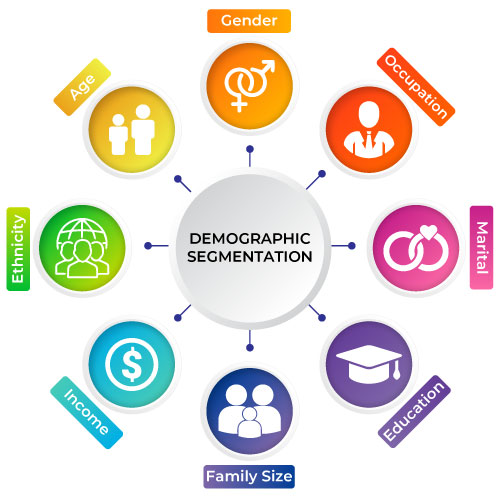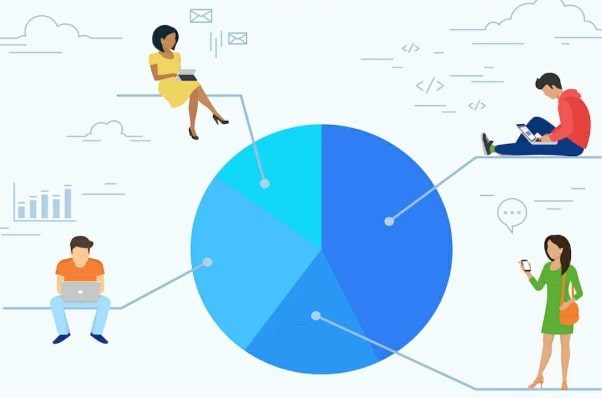Customer Segmentation Guide
Inci Vardar
Imagine that you have decided to make a significant change in your life, for example, moving to another city. You need to inform your family, friends, and colleagues of this development. So, will you talk to each and every one of them with the same sentences and tone of voice, or will you adapt your declaration for different audiences according to what they need to hear and how you want to make them feel? We normally do this kind of segmentation with people in our lives without thinking; it’s a built-in feature of humans. When it comes to business, we need to do the same a little more consciously. This deliberate reframing process is called customer segmentation.

What Is Customer Segmentation and Why Is It Important?
Customer segmentation is grouping your customers according to their shared characteristics, such as age group, geographic location, interests, and pain points. This segmentation helps you tailor your marketing messages for different groups of people and address them in a more personalized manner.

Although customers are reluctant to provide personal information to brands, they are quite keen on receiving personalized offers. According to Accenture’s report, 91% of consumers are more likely to shop with brands that recognize, remember, and provide relevant offers and recommendations.
If you are familiar with the terms “Boomer / Generation X” and “GenZ”, it is easy to guess that you’ll have difficulty communicating with these two groups using the same language patterns. While one thinks of the selfie camera as the invention of the century, the other is trying to find out about the intricacies of deep fake to replace faces. So if you are trying to sell a tech product, one size can never fit all, either with your marketing copy or the visuals you present.
The age gap is only one example of customer segmentation. When grouping your audience, you need to consider other differences as well.
Types of Customer Segmentation
You can group your customers based on literally anything. For example, you can try to sell your new formula of hair conditioners only to people with curly hair, create a sales campaign that only social shoppers can benefit from, or you can add an alcohol-free beer variant that primarily targets pregnant women to your product range. But the most common types of segmentation can be covered in 8 methods, along with a couple of hints and best practices.

Demographic Segmentation: This segmentation informs you about your customer’s age, gender, income, education, and marital status. Usually, having this information makes all the difference since you won’t try to show an ad for a gold-plated bedroom set to a 12-year-old public school student.

- Geographic Segmentation: Knowing where your customers live, work, or hang out can help you determine pricing, offer different language options, and create location-based campaigns. For instance, if you have a coffee brewery franchise, you can launch your new product in your stores near universities and give young people a fresh taste of innovation.
- Behavioral Segmentation: Different customers can use your product for different reasons. For example, some can use a dishwashing liquid as an all-purpose cleaner. Behavioral segmentation shows how customers interact with your brand, product, or service.
- Psychographic Segmentation: Personal interests and motivations play a significant role in choosing the brand we buy from. For example, some customers prefer cosmetic brands that do not test on animals or consider social responsibility activities when choosing between brands that offer similar products.
- Technographic Segmentation: This segmentation shows which technological devices your customers use to interact with your brand. This is important because, as we explained in e-commerce conversion rates, customers make a significant amount of browsing on mobile, but many of them switch to desktop devices when it comes to the actual purchase.
- Needs-based Segmentation: Design and functionality play an important role in product preferences. For example, the dimmer function in lighting appliances is a must-have for some customers, while others can be content with a simple on/off button.
- Value-based Segmentation: Some brands and products present value beyond their functionality. People who shop at Zara are not usually Louis Vuitton buyers.
- Customer Journey Segmentation: This segmentation groups customers based on the customer journey stage. You can run different campaigns simultaneously. One can raise awareness among those who have never heard of your brand, and the other can deliver the functional benefits of your product to those in the consideration stage.

You can add different metrics and create different segments based on your specific needs, but first, you need to aggregate clean and usable data to avoid misinformation. Avoiding common pitfalls in customer segmentation starts with a clearly defined strategy.
How to Collect and Analyze Customer Data for Segmentation
Customer segmentation is all about concrete, calculable data. You can’t make “guesstimations”, ignore some of the communication channels, or skip the reporting and optimization processes. In order for the customer segmentation to work, you need to put up a smart strategy that covers goals, priorities, customer insights, analysis, and optimizations.

- Defining Customer Segmentation Goals
Changing the way you do business or introducing a new level of complexity needs to provide achievement in return. The same goes for customer segmentation. Why do you want to create different buyer personas? What kind of information do you need from your customers, and how will you use this data? If you don’t define the outcome that you desire, you can ask all kinds of questions, even learn the shoe sizes of all your customers; but if you don’t know what to do with all that information, it only means that you are wasting valuable time and resources.
- Establishing Scope
Not wasting time and resources requires you to work within a frame. It’s important to set parameters for the number of segments you want to create, the sources you can pull data from, the time frames of your data collection processes, the minimum number of individuals you need to reach in order to make the data meaningful, how your loyal customer base can be utilized, how to ensure data privacy and security, and so on.
- Deciding on the Data Collection Projects
Different projects deliver different kinds of data, and you may need to prioritize in order to use your resources more efficiently. You can use polls on social media platforms, conduct social listening, create a sweepstakes campaign to aggregate phone and email information, send out surveys through email, or make an entire website dedicated to fun tests that can provide you with behavioral data. When you obtain enough usable data, you can organize the largest segments first and start building your communication messages according to their needs and preferences.
- Targeting in a Customer-Centric Manner
Like mentioned earlier, who you are addressing should determine what you say and how you say it. If your target audience shops mainly on desktop computers, don’t try to push them to shop on mobile. If a large percentage of your customers are using Facebook, don’t try to reach them on TikTok. If youngsters are your primary target audience, avoid nostalgic connotations in your marketing messages. After all, you didn’t put your energy into all this customer segmentation only to send the same message to every customer.
- Analyzing and Optimizing the Results
After collecting, organizing, and using customer data, you need to revisit and optimize them from time to time. After tracking segment performance over time, you might realize that some of the segments you have created aren’t really necessary or profitable. Some segments might work better on different platforms or at different times of the day. Some insights can help you form new clusters and create different personas. This way, you can assess the behavioral changes over time, get a long-term view of your customer base and address the newcomers in a more efficient manner.
Obviously, it is a lot of work, and the amount of collected data can look overwhelming. But the benefits of customer segmentation and its impact on your business when used correctly outweigh the challenges.
Using Customer Segmentation for Business Growth
Reading this far, you probably have some ideas on why customer segmentation is important for your business. Yes, you can personalize your content according to buyer personas. Yes, you can get more of your marketing efforts by delivering the right solutions at the right time. Yes, you can put more emphasis on the customers that offer a better lifetime value and even identify new opportunities for products and services. But there is more.
- Improving Customer Acquisition with Segmentation
Your repeat customers can provide you with valuable information on how to reach new ones that fit your criteria. Taking a closer look at your existing customers can help you create ideas for referral campaigns and awareness projects to collect leads.
- Enhancing Customer Retention with Segmentation
By determining which segments of customers drive more sales, word of mouth, and profit, you can create better-targeted campaigns with improved messages. Customer segmentation projects can increase engagement and provide you with upsell opportunities.
- Optimizing Customer Experience with Segmentation
Customer needs and preferences can change over time. By segmenting customers and tracking their performances, you can optimize their overall experience by making adaptations to your products, services, and communication efforts.
Leveraging Technology for Better Customer Segmentation

Life is too short to handle immense amounts of data manually. Sooner or later, you’ll need to utilize some technologies to collect, organize and make sense of this raw material. Thanks to many useful features, Juphy is one of those technologies that can make your life easier.
First of all, Juphy allows you to conduct social listening. You can determine some keywords related to your brand, products, or competitors initially to define your target audiences and make educated guesses about their preferences.
You can also create automation rules, a feature that helps you categorize incoming messages with tags. Let’s say you sell books, and prospects ask you about the genres through social media DMs. You can tag incoming messages like horror, sci-fi, romance, etc. When related keywords are used in the messages, Juphy automatically links the message with the appropriate tag, and you can predict your best sellers intuitively. What’s more, this feature works with ad comments as well.
Lastly, the reports section shows your channel performances. You can find out which of your social media accounts receive more interaction, focus your communication efforts on them, and obtain more data in return.
Final Thoughts
If you are not sure how to start segmentation, give some thought to what you need to know about your customers. Don’t try to collect every little piece of information “just in case”, but justify every question you ask them and use the answers to provide you with more relevant insight. Many of your potential customers are already online, talking to each other about brands and products. You can try Juphy for free and start listening to their conversations to translate them into useful information.
FAQ
Customer segmentation is grouping your customers according to their shared characteristics such as age group, geographic location, interests, challenges, etc.
You can segment your customers based on many aspects, but the most frequently used segmentations are demographic, geographic, behavioral, psychographic, technographic, needs-based, value-based, and customer journey-based.
No product or service is intended for the whole world. You can identify your customers based on their age, location of residence, personal interests, and specific needs.
The primary goal of customer segmentation is the personalization of marketing messages. But segmenting customers can provide you with insights and help you improve acquisition, retention, and overall customer experience.
Related Article – Customer Profile: Creating and Targeting Ideal Customers

Are you tired of wasting resources on the wrong sets of customers? Find out how to create your ideal customer profile for better targeting! Read more now!

